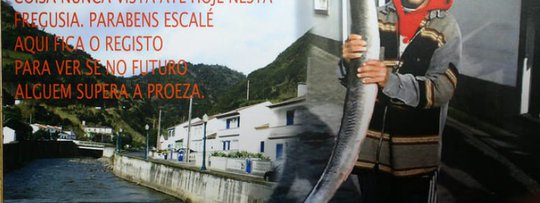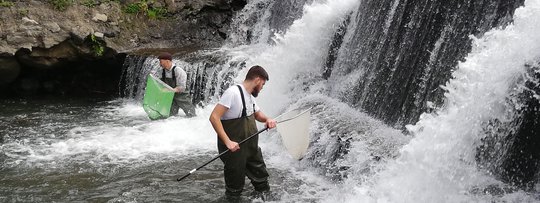O projeto
The primary aim of the project is to increase the knowledge of the oceanic phase of eels undertaking their spawning migration, and ultimately the spawning behaviour itself. As such, this project aims to answer a centuries old question and to use this to publicise the concerning status of this incredible species but also of the marine environment that it, and so many other species, rely upon.
There have been attempts to use satellite tag technology to track the migration of European eels, and part of the route has been identified. However, the length of the migration is greater than the battery life of available technology. The Azores are the closest land masses to the Sargasso Sea known to have this species in their freshwater systems and as such we have been focussing our efforts here. We have already established that it is possible to tag escaping silver eels. From October to December 2019 we will work to capture migrating silver eels with the aim of applying up to 20 satellite tags. This will be the first time this species has been tagged in this region and ensuring we have sufficient numbers for robust analysis is essential.
Our project has the following specific objectives:
- Employ seasonal workers across key sites in the Azores to further understanding of eel populations and the timing of the spawning migration on these islands
- Satellite tag up to 20 escaping silver eels.
- Combine data from this study with previous data to develop an understanding of:
- the migration of this species to the spawning area in the Sargasso Sea.
- the spawning behaviour of this species – a phenomenon that, to date has yet to be observed.
- Produce a short film on the efforts of the researchers to carry out this work and ultimately answer a centuries-old question of where this species breeds.
- More broadly use this information to engage with both the public, policymakers and other scientists on how, due to its unique life history, the European eel is a hugely important species as far as being an indicator of aquatic health and connectivity.
Activity 1 - Ecology of the European eel in the Azores
Dedicated to understanding the timing and drivers of downstream eel migration, this activity proposes to conduct field trials to determine distribution, population dynamics and movements of European eels in the Azores and other key locations. Involving the work of a PhD student, this task will generate empirical data on eel populations, yellow and silver eel movements (and passage) in a range of watercourses in the Azores. This PhD is part of a research cluster specialising in eel research at the University of Hull, working in collaboration with the Environment Agency and Zoological Society of London. Understanding the timing of silver eel migration informs operational changes to facilitate eel passage at critical times and reduce anthropogenic mortality of structures, such as pumping stations and hydropower turbines. There is currently no information on silver eel migration in the Azores, a knowledge gap this PhD aims to address.
Detailed eel movement studies using acoustic telemetry will be conducted at representative watercourses in the Azores to understand the behaviour of eels in utilising freshwater and marine habitat during their growth phase, identification of barriers to upstream migration and timing of downstream silver eel migration, which is essential for catching eels for monitoring their onward migration using satellite tags.
Acoustic telemetry arrays will be placed at strategic structures and locations to monitor upstream and downstream migration of tagged eels. All relevant environmental data (e.g. water levels, flow, temperature, salinity, state of tide etc.) will be continuously recorded and analysed in relation to eel movement patterns. Fin clips will be obtained for stable isotope analysis for dietary information and genetic material to contribute to the European database. The presence of the parasite, Angullicoides crassus will be assessed using ultrasound techniques. This parasite infects the swimbladder and may seriously affect the ability of silver eels to complete their migration. It is prevalent in the UK and Europe, so if eels from the Azores are not infected, the chance of successful migration is increased.
Eels will be captured using a range of methods including traps, fyke nets, electrofishing and angling. Tagging will be performed under licences issued by Home Office and the Azores Government. Telemetry arrays, cameras and all other gauging equipment will be set up to monitor movements and environmental conditions. EA and UAc staff will be responsible for obtaining all necessary permissions and access to install equipment and conduct work.
While a great deal of this work will be carried out in transitional and freshwaters, the continental phase of the eel’s life history has direct relevance to the success of the marine phase. As such it is essential that we understand the behaviour of the species and how threats in continental waters can impact the species spawning potential.
Activity 2 - Satellite tagging
To date, satellite tagging projects during the past 10 years have hugely increased our understanding of the migratory behaviour of maturing eels. We now know that they carry out vertical diurnal migrations and are also preyed upon by a range of apex predators. We also know that the migration pattern of tagged individuals is towards the Sargasso Sea; however, to date no tagged European eel has completed the spawning migration.
In the latter part of 2018, following pilot studies to identify areas where large silver eels are present, our team will aim to satellite tag 20 migrating eels on the Azores. As the Azores is the landmass closest to the Sargasso Sea we are confident that tagged eels will migrate further than any previous study. Our team is made up of researchers who have experience in remote telemetry and includes two of the authors on the first published study of satellite tagging of this species.
The data from this study will be received at the time the present, proposed study commences and we will use this to engage with both our peers and the public. The data will be a unique insight into the migration of the species which will provide excellent outreach opportunities. It will also be used to guide the second stage of our tagging study. This will mean that we are able to optimise the individuals that we use, the programming of tags and build a more powerful data set. With this increased understanding of the migratory behaviour, we would aim to programme tags such that eels would be monitored all the way to their spawning grounds - this would be answering a ~200 year old question. In addition to this it would give us a unique insight to the spawning behaviour of the species, again, something that has never been observed in the wild. This information would be of global relevance both to scientists, policy-makers and the public, with enormous out-reach potential. Our team has a range of expertise in the fields of policy, science and media-engagement and would aim to capitalise on the results through peer-reviewed publications, national and international media, national and international policy (e.g. CITES, CMS, UNCLOS, EU Eel Regulation), and an online presence through a dedicated website where the migration routes of tagged fish can be visualised.
Activity 3 - Filming
The purpose of this twenty minute film is to raise awareness of the work done to confirm the spawning grounds of the European eel, and to highlight the huge decline in their abundance due to a range of impacts (largely man-made). The audience will be members of the general public with an interest in wildlife and the environment.
The introduction will provide an accessible overview of the unusual life cycle of this species, touch on its cultural significance as a traditional seasonal European fishery and highlight that, although evidence suggests their breeding grounds are the Sargasso Sea this has not been confirmed. To date it has only been possible to track satellite tagged eels to the Azores.
The “first act” will present the chance encounter with a local ecologist with an anecdote of populations of European eels in some of the rivers of the Azores islands. As the islands are located roughly half-way between Europe and the Sargasso, it was proposed this may be close enough for satellite tagged eels to be tracked all the way to their intimated breeding grounds. The film then follows the efforts of members of the team to identify the rivers using cutting edge scientific methods and then catching, tagging and releasing adult eels large enough to carry satellite tags.
The “second act” covers the enormous decline in eel recruitment (~90%) since the mid-20th Century and outlines the range of negative impacts on eels (overfishing, barriers to migration, climate change). This is followed by a brief overview of the work of EA to ameliorate eel impacts and a short “case study” of one of the visually engaging methods such as eel ladders, some of which are big enough to bypass enormous hydroelectric dams.
The “third act” focuses on the migration of the adult eels from the Azores to their spawning grounds. This activity is fraught with uncertainty as nothing is known of the route taken or the depth at which the eels migrate or spawn. Staff wait nervously for signals to be received from the tags, pinpointing the position of their release and, all fingers crossed, solving the mystery of the location of the European Eel spawning grounds.
Activity 4- Public engagement
Public participation is seen as a crucial element of the project, in order to reach two complementary objectives:
-
obtain relevant information on the distribution of the different life stages (an element of citizen science)
-
increase awareness for the species, pushing for a wider recognition as the only native freshwater fish in the Azores and disseminating the main conservation measures that need to be taken.
To reach these objectives we are envisaging the (i) creation of a dedicated website and corresponding presence in social networks (including Facebook, Twitter and Instagram), (ii) production of a factsheet on the conservation status of the European eel and the measures that need to be taken to protect it in the Azores, (iii) production of a leaflet on the EELtrek project, its information needs and how they can be forwarded to the project team and (iv) a presentation summarizing these elements.
We will proceed to disseminate these materials through talks in schools (including the university), government departments, environmental organizations, river users (farmers, municipalities) and sports and professional fishers associations. High-school students will be invited to take part in sampling excursions, whereas offers for participation (with projects or MSc thesis) will be actively promoted among local university students.



